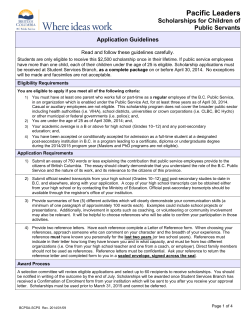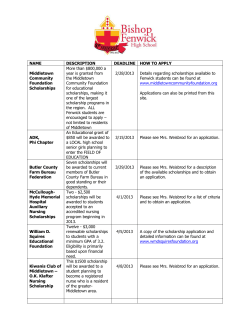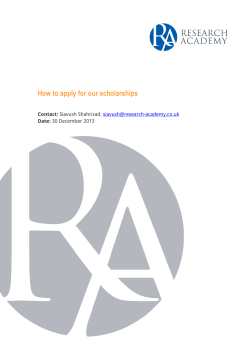
University of Victoria NSERC CGS/PGS Grants Facilitation Tips for NSERC Doctoral Scholarship
1 University of Victoria NSERC CGS/PGS Grants Facilitation Tips for NSERC Doctoral Scholarship Applications (CGS & PGS ‘D’ Applications) 10 September 2014 Dr. Brad Buckham UVic NSERC CGS/PGS Grantscrafter bbuckham@uvic.ca Overview • (Following the maxim of the 5 W’s and 1 H…) – – – – – – What is NSERC? What is a CGS/PGS application? Why should I apply? Who are the people evaluating my application? Where can I tenure the award? How do I craft a successful proposal? When can I meet with the UVic NSERC Grantscrafter & When do I submit? 3 What is NSERC? • • • NSERC – Natural (a.k.a. “National” ) Sciences and Engineering Research Council. NSERC represents 1/3 of the Canadian Tri-council and is the primary granting agency for academics studying in the Natural Sciences & Engineering (NSE). NSERC – for Students: • Canada Graduate Scholarships (CGS). • Postgraduate Scholarships (PGS). • “…ensure a reliable supply of highly qualified personnel to meet the needs of Canada's knowledge economy…and be the research leaders of tomorrow.” 4 What is a CGS/PGS application? • A CGS/PGS-’D’ application has 4-5 distinct components that need to be completed: • Form 201: personal data, academic background, research/work experiences, location of tenure. • Outline of Proposed Research (“free” form). • Justification for Eligibility of Proposed Research (“free” form). • Applicant Contributions & Statements (“free” form). • Referee reports. • Collectively, these components must present the 5 W’s and 1 H that define your MASc or PhD research program (Who, What, When, Where, Why & How). 5 What is a CGS/PGS application? Form 201 Front Matter Application profile, person profile, experience, start date & location Who When Where Outline of Proposed Research (1 pg.) Describe the MASc or PhD research project. Justification for Eligibility of Proposed Research (1 pg.) What How Why If the field of study falls into CIHR or SSHRC territory, describe the NSE challenges that the research addresses. Is the research being completed in an established NSE research program? Candidate’s Statement (2pg. CGS/PGS-D) Part I: Contributions to research and development Part II (PGS-D): Most significant contributions Who Part III: Applicant’s statement Referee’s Report (x2) Why is this applicant worth the investment. Can the applicant complete a graduate level research project? What is the value of the research itself? Who Why 6 What is a CGS/PGS application? Outline of Proposed Research 1. What: Describe clearly the research challenge in your project. Provide background information to position your research within the context of the field. State the objectives and the hypothesis. 2. How: Describe what you will do. Outline the experimental or theoretical approach to be taken. Ensure the methodology fits within the constraints of the PhD program. 3. Why: State the significance of the proposed research to a field or fields in the natural sciences and engineering. What are the benefits to Canada. How will the research results facilitate further work in the area? 7 What is a CGS/PGS application? What are the benefits to Canada? • You, and possibly the project itself. • The members of the selection committee are investing federal $’s. They are evaluating potential returns on that money. Scope of your CGS/PGS project • A return on that investment is not likely to be realized in the short term. • In the span of 3-5 lines, can you show you have the long term vision to be “a research leader of tomorrow?” Scope at which the “Benefit to Canada” is evident 8 Why should I apply? • • …to be a research leader of tomorrow. NSERC supports: • • • • “…high-calibre Canadian graduate students in building global linkages and international networks through the pursuit of exceptional research experiences.” • “... the training of teams of highly qualified students that address significant scientific challenges associated to Canada's research priorities.” The PGS application process is an excellent exercise in identifying research goals and career objectives. Somewhere between $21,000-$35,000 in financial support 3-4 pages to glory... 9 Who are the people evaluating my application? • At NSERC, applications are reviewed by one of twelve selection committees. • Committees are formed by university faculty selected from across Canada who serve a fixed term. Applications are assigned to a committee based on the expertise required to evaluate the proposal. Although each member scans every application, usually two selection committee members read an application in detail and present it to their colleagues for discussion and evaluation during the competition. NSERC then makes awards according to Committee recommendations, and insofar as the budget for that year permits. • • • 10 Who are the people evaluating my application? NSERC Scholarships and Fellowships Committees: 168 Scholarships and Fellowships Selection Committee for Earth Sciences. 169 Scholarships and Fellowships Selection Committee for Evolution and Ecology. 177 Scholarships and Fellowships Selection Committee for Mathematical Sciences. 178 Scholarships and Fellowships Selection Committee for Physics and Astronomy. 179 Scholarships and Fellowships Selection Committee for Chemistry. 187 Scholarships and Fellowships Selection Committee for Cellular and Molecular Biology. 11 Who are the people evaluating my application? NSERC Scholarships and Fellowships Committees: 193 Scholarships and Fellowships Selection Committee for Civil and Mechanical Engineering 194 Scholarships and Fellowships Selection Committee for Chemical, Biomedical and Materials Science Engineering 195 Scholarships and Fellowships Selection Committee for Plant and Animal Biology 196 Scholarships and Fellowships Selection Committee for Psychology 197 Scholarships and Fellowships Selection Committee for Electrical Engineering 198 Scholarships and Fellowships Selection Committee for Computing Sciences 12 Where can I tenure the award? • • Form 201 allows you to specify three proposed locations of tenure. For PGS-D applicants, the Form 201 front matter is the only place where the question of Where is addressed… “You may take up your PGS M or PGS D at any eligible Canadian university. You may also take it up at any eligible foreign university, provided you have received a previous degree in the natural sciences or engineering from a Canadian university.” • …unless your proposed area of study crosses into the social sciences or health domains 13 Where can I tenure the award? • …unless your proposed area of study crosses into the social sciences or health domains. • In this case, the “Justification for Eligibility of the Proposed Research” attachment has to clearly show that the research “...advance[s] knowledge in the NSE.” • One component of that justification could be the track record of the NSE research program that you are joining. • If so, then you can discuss how the proposed work builds on past accomplishments of that program in the NSE domain. • This can supplement the “Outline of Proposed Research.” • Save the research proposal for discussion of your work. 14 How can I craft a successful proposal? • • READ THE INSTRUCTIONS. It is surprising how many people don’t do this, and then get in trouble. • “Free” form is not actually free. Far from it. • If your research subject spans tri-council disciplines you need to get assistance targeting one agency. • Faculty of Grad Studies can solicit NSERC feedback based on your draft free-form attachments. Also make sure that you read and understand the criteria that will be used by the committee to assess the risk associated with investment in you. 15 How can I craft a successful proposal? Academic excellence: • • • academic record; scholarships and awards held; and duration of previous studies. Research ability or potential: • • • • • • • quality of contributions to research and development; relevance of work experience and academic training to field of proposed research; significance, feasibility, and merit of proposed research, and justification for location of tenure; ability to think critically; ability to apply skills and knowledge; judgement; originality; 16 How can I craft a successful proposal? Research ability or potential cont’d: • • • initiative and autonomy; enthusiasm for research; and determination and ability to complete projects within an appropriate period of time. Communication, interpersonal and leadership abilities: • The ability or potential to communicate scientific concepts clearly and logically in written and oral formats. For example, this could include: • quality of the application's presentation; • participation in preparing publications; and • awards for oral presentations or papers. • professional and relevant extracurricular interactions and collaborations. 17 How? (to show you meet the criteria) • Academic excellence. • • • Research ability or potential. • • • • Transcripts. Form 201 - MASc research overview. Research Proposal Contributions and Statements – Parts I & II. Referee reports. Communication, interpersonal and leadership abilities. • • • Research Proposal Contributions and Statements – Part III. Referee reports. 18 How? (to show you meet the criteria) Selection Criteria Weightings CGS/PGS M CGS/PGS D • Academic Excellence 50% 30% • Research ability or potential 30% 50% • Communication, interpersonal and leadership abilities 20% 20% 19 How? (to prepare the free form attachments) • Follow the specifications for the free form sections. • 1 pg: “Outline of Proposed Research”. • 1 pg: “Justification for …Research” • 2 pg: “Contributions & Statements”. • Celebrate “white space” – Use section headings to separate out sections of the proposal. • References – used to support your statement of the research program’s central problem. • How many are needed to do this? Is such support required at all? • You are under the microscope – not other researchers already working in your chosen field. 20 How? (to prepare the research proposal) Title Opening paragraph. Problem statement, background information and motivation. Objectives. What you are going to do? Methodology. How are you going to reach your objectives? A high level description of numerical & experimental technique and process. The committee understands that plans change. Contributions. Why is the research worth pursuing? What are the benefits to Canada? How will your work contribute to Canada’s “knowledge economy”? 21 How? (to prepare the research proposal) • Make sure to follow the formatting specified in the Form 201 Instructions. • 0.75” (1.9 cm) margins all around. • No smaller than a 12pt Times New Roman font. • Recommend 6 pt spacing before and after paragraphs. • Ensure your name and NSERC PIN (if you have one) are in the header/footer. • “Outline of Proposed Research” is NOT a title. Use the header/footer to indicate this (similar to the Form 201 pages). 22 How? (to prepare the Candidate’s Statement) • The Statement is a chance to show that you can be relied upon to deliver. • It's not a game of "who gets the highest publication score", but who delivers well and on time so that scarce public funds are not dissipated. • Part I - Quality counts more than quantity. • Formatting is very rigidly defined. See the Form 201 Instructions. • Note that the instructions are very emphatic that Parts II and III must contain different information. 23 How? (to prepare the Candidate’s Statement) Part I – Contributions to research & development • A numbered list of publications, technical reports, poster presentations, … • Form 201 instructions list lettered subheadings to use within Part I: a. Articles published or accepted in refereed journals … b. Articles submitted to refereed journals … • If you have nothing to list in a section (or subsection) keep the heading in and list the contents as N/A or “none at this time”. 24 How? (to prepare the Candidate’s Statement) Part II – Most significant contributions to R&D • This is a chance to emphasize the quality of selected contributions listed in Part I. • For (up to) three selected Part I items: • Describe your role in the research. • Clarify your contribution to collaborative research. • Provide details, as appropriate, on the significance of technical reports. 25 How? (to prepare the Candidate’s Statement) Part III – Applicant’s Statement • A. Research Experience. • • • include special projects, honours thesis and relevant co-op reports. B. Relevant Activities. • professional and extracurricular activities that most demonstrate your communication, interpersonal, and leadership skills. C. Special Circumstances (detrimental). • special considerations that have had an effect on your performance or productivity. • “If your supervisor is unable to provide you with a Report on the Applicant, you may use this section to provide an explanation.” 26 How? (to select/solicit your referees) • The reference letter needs to present an accurate and complete picture of your achievements and research potential. • The more information a referee has to draw from, the better the case for support he/she can make for you. • Draft Proposal and Contributions & Statements • 1 pg. Highlight sheet – why should the referee jump at taking you as a CGS/PGS scholar? Pull your best points from your draft attachments • A chart showing your sessional/cumulative GPA progression? • http://www.uvic.ca/graduatestudies/finances/financialai d/scholarshipapps/index.php 27 When can I meet with the UVic NSERC Grantscrafter? • UVic internal deadline is 4:30pm, October 1 st. • First review (content, organization, clarity) • • September 15-19. • September 22-26. Second review (fine tuning) • September 24-27. • Organize meeting times via email. (bbuckham@uvic.ca). • Meet in EOW 531. 28 Final Comments • When all is said and done, grants competitions are still going to be unfair on occasion. It is not a perfect world. • Please remember that after one rejection, you do not need to despair. • When you rewrite the application use the advice you can accept and make sure you have covered off the rest. • Applying for grants is actually a professional skill — one skill in an academic’s bag of tricks. • Scholars who are good at getting grant money are looked upon with significantly greater favour by university hiring committees than those who are not. 29 Technicalities UVic Graduate Studies http://www.uvic.ca/graduatestudies/finances/financialaid/externalawards/ind ex.php Scholarships Officer: Ms. Yvonne Rondeau - scholoff@uvic.ca Scholarships Officer: Ms. Kathy McCarthy - fgsaward@uvic.ca NSERC PGS/CGS Program overview: http://www.nserc-crsng.gc.ca/Students-Etudiants/PG-CS/BellandPostgradBelletSuperieures_eng.asp Form 201 Instructions: http://www.nserc-crsng.gc.ca/OnlineServicesServicesEnLigne/instructions/201/pgs-pdf_eng.asp Scholarships & Fellowships Committees: http://www.nserc-crsng.gc.ca/NSERC-CRSNG/Committees-Comites/programsprogrammes_eng.asp
© Copyright 2025


















